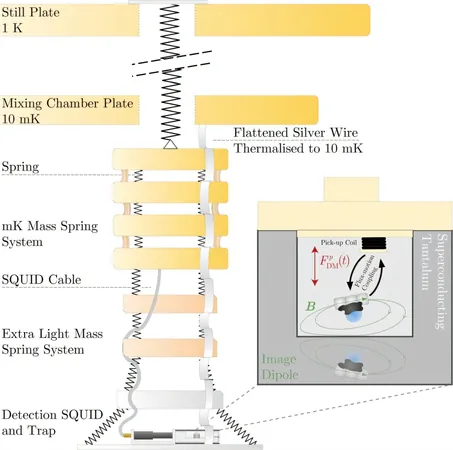
Unlocking the Mysteries of the Universe: Researchers Use Magnetically Levitated Particles to Hunt for Dark Matter
2025-06-25
Author: Daniel
Dark matter remains one of the universe's greatest mysteries, making up a staggering portion of its total mass while eluding direct observation. A groundbreaking theory proposes that ultralight dark matter might behave like a continuous wave, producing rhythmic forces detectable only with ultra-sensitive quantum technology.
A pioneering study led by physicist Christopher Tunnell at Rice University, and featuring postdoctoral researcher Dorian Amaral as the lead analyst, marks a critical step in the quest for ultralight dark matter by utilizing a magnetically levitated particle.
In an innovative collaboration with physicists from Leiden University, the team achieved a remarkable feat by suspending a microscopic neodymium magnet within a superconducting environment, cooled to near absolute zero. This unique setup was engineered specifically to detect minute oscillations suspected to be triggered by dark matter waves coursing through the Earth.
A New Era of Dark Matter Detection
Tunnell remarked, "Our approach brings dark matter detection into a new realm. By suspending a tiny magnet in a frictionless environment, we're granting it the freedom to respond to potential dark matter interactions." The team monitored this levitated magnet with astonishing precision, employing sensors capable of detecting movements smaller than a single hydrogen atom.
Although they did not uncover the anticipated signal, this lack of evidence was not in vain. It enabled physicists to refine their understanding by ruling out specific interactions between dark matter and regular matter.
The researchers focused on identifying forces from dark matter interactions that vary with baryon and lepton numbers, fundamental constants that persist through particle interactions, under a theoretical framework known as B−L. Their targeted search centered around a narrow frequency band at 26.7 Hz, thereby establishing new limits on the strength of these elusive interactions.
Charting New Territory in Dark Matter Research
Tunnell explained, "Every time we don't find dark matter, we refine the map. It's like searching for a lost key in your house; each failure guides you to new areas to investigate." Building upon these insights, the researchers proposed an ambitious next-generation experiment named Polonaise. This initiative aims to amplify sensitivity and broaden the search spectrum for dark matter.
The name 'Polonaise' humorously draws from the dance the physicists performed upon realizing the viability of their measurements during a climate protest. The upcoming setup promises to utilize heavier magnets for more stable levitation and expand the frequency range under investigation.
"Our future setup won't just listen more closely; it will be finely tuned to hear signals we've never even considered," stated Tunnell. Amaral, who collaborated on the theoretical foundation of this work with Professor Mustafa Amin, emphasized the significant implications of these experimental advancements.
"We're not merely testing a theory; we’re laying the groundwork for an entire class of measurements," Amaral noted. The innovative use of magnetic levitation paves new avenues for uncovering weak, long-range forces, achieving sensitivity on par with the weight of a single virus. This exciting research effort also includes contributions from Leiden University collaborators Dennis Uitenbroek and Tjerk Oosterkamp.





 Brasil (PT)
Brasil (PT)
 Canada (EN)
Canada (EN)
 Chile (ES)
Chile (ES)
 Česko (CS)
Česko (CS)
 대한민국 (KO)
대한민국 (KO)
 España (ES)
España (ES)
 France (FR)
France (FR)
 Hong Kong (EN)
Hong Kong (EN)
 Italia (IT)
Italia (IT)
 日本 (JA)
日本 (JA)
 Magyarország (HU)
Magyarország (HU)
 Norge (NO)
Norge (NO)
 Polska (PL)
Polska (PL)
 Schweiz (DE)
Schweiz (DE)
 Singapore (EN)
Singapore (EN)
 Sverige (SV)
Sverige (SV)
 Suomi (FI)
Suomi (FI)
 Türkiye (TR)
Türkiye (TR)
 الإمارات العربية المتحدة (AR)
الإمارات العربية المتحدة (AR)